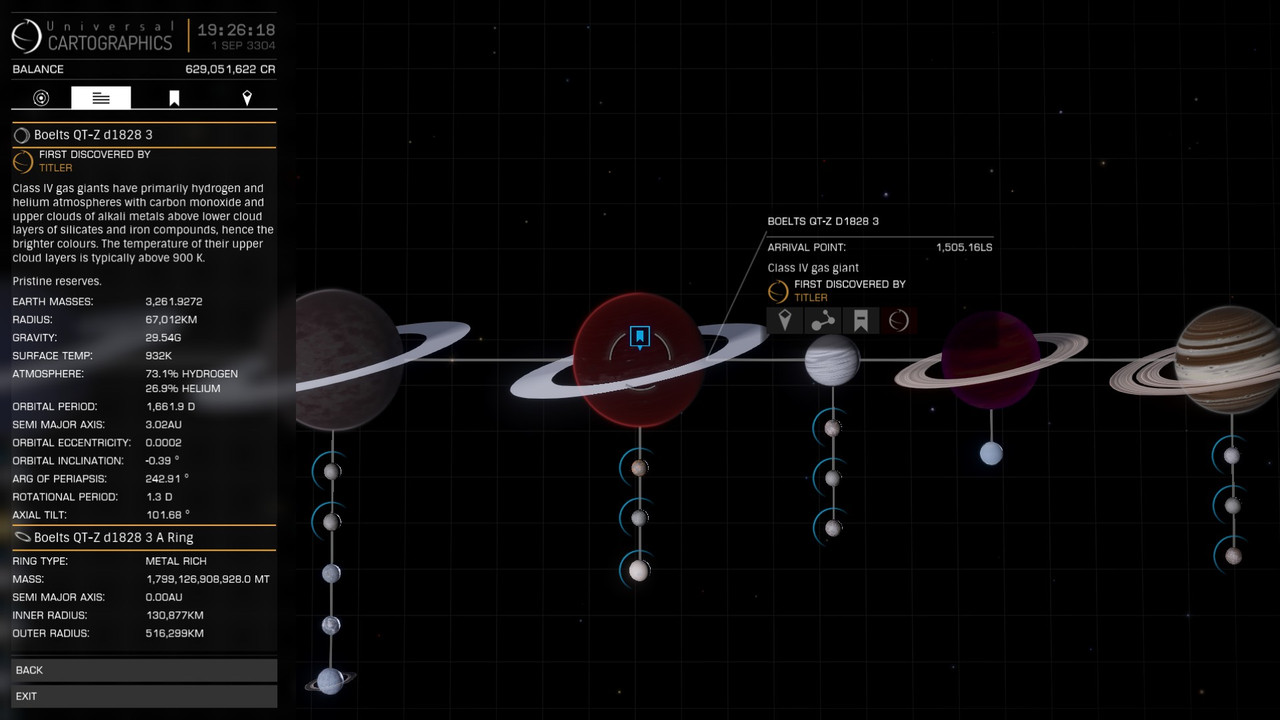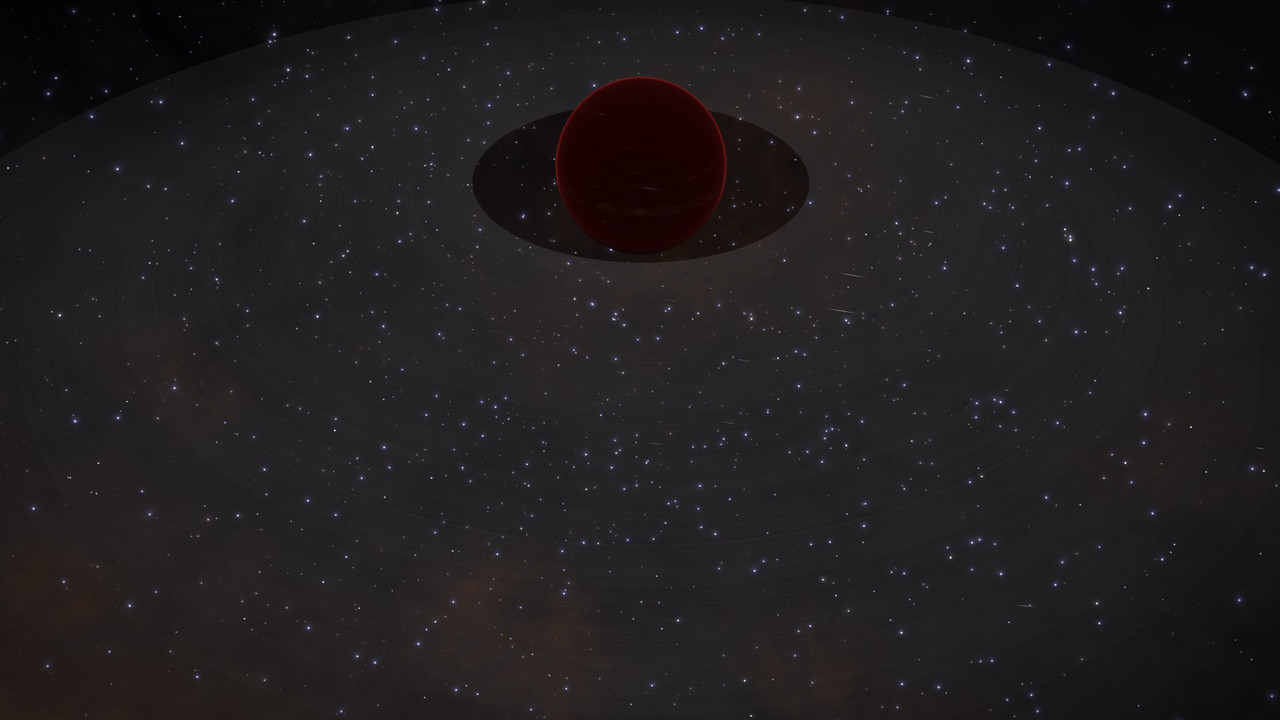You are using an out of date browser. It may not display this or other websites correctly.
You should upgrade or use an alternative browser.
You should upgrade or use an alternative browser.
Oh no, the Ur-Quan have slave-shielded Slylandro homeworld!
- Thread starter Zieman
- Start date
+1 rep for the Star Control reference! 
They're not super common, but I don't think they're super rare either. It means the gas giant is almost on the cusp of being categorized as a brown dwarf instead. It's generating heat via gravitational collapse, like a brown dwarf, but isn't quite up to that scale. I don't have any numbers on it though.
If the stellar forge handles it realistically, then we should be able to find these in the EDSM data by looking for gas giants within a certain temperature range. The red glow is effectively "black body radiation" (a fancy way of saying "heat glow").
Do you have data on this planet? Specifically temperature, radius, mass, etc?
They're not super common, but I don't think they're super rare either. It means the gas giant is almost on the cusp of being categorized as a brown dwarf instead. It's generating heat via gravitational collapse, like a brown dwarf, but isn't quite up to that scale. I don't have any numbers on it though.
If the stellar forge handles it realistically, then we should be able to find these in the EDSM data by looking for gas giants within a certain temperature range. The red glow is effectively "black body radiation" (a fancy way of saying "heat glow").
Do you have data on this planet? Specifically temperature, radius, mass, etc?
And +1 back for getting the reference!+1 rep for the Star Control reference!
That's not the phenomenom in case here. The glow is something I don't recall seeing before.Class IV giants are commonly dull red. If you read the description for Class IV giants, it mentions "iron compounds" in the clouds; hence the rust-colours.
3527.44 Earth masses
65535 km radius
936 K surface temp
Yep, that makes perfect sense. It's a very high mass planet, and the gravitational collapse is keeping it pretty hot. At around 1,000 K, it should glow red. Check out the chart here:
http://www.giangrandi.ch/optics/blackbody/blackbody.shtml
(copied below)
1,000 K - Red
1,500 K - Reddish orange
2,000 K - Yellowish orange
2,800 K - Yellow
3,500 K - Yellowish white
4,500 K - Warm white
5,500 K - White
And this, from the black body radiation wikipedia page:

Last edited:
Some additional info.. In my copy of the EDSM data, I have over 45,000 gas giants that are at least 1,000 K in temperature, with the hottest being over 13,000 K. In that range, it should be lit up a brilliant blue, like a small blue star in the A/B class range. Somehow I doubt the game is rendering the right color temperature at those high temps.  I suspect these ridiculously hot planets are due to proximity to the star, but haven't checked. The game is probably only looking at the heat coming from its gravitation when deciding how to render it, which will make them mostly dim-red as long as they're smaller than brown dwarfs, but still large enough to have a visible heat emission.
I suspect these ridiculously hot planets are due to proximity to the star, but haven't checked. The game is probably only looking at the heat coming from its gravitation when deciding how to render it, which will make them mostly dim-red as long as they're smaller than brown dwarfs, but still large enough to have a visible heat emission.
Here are the hottest 25 in the list:
Here are the hottest 25 in the list:
Code:
mysql> select name,subType,radius,gravity,earthMasses,surfaceTemperature from planets where surfaceTemperature>1000 and subType like '%giant%' order by surfaceTemperature desc limit 25;
+-----------------------------+-------------------+---------+---------+-------------+--------------------+
| name | subType | radius | gravity | earthMasses | surfaceTemperature |
+-----------------------------+-------------------+---------+---------+-------------+--------------------+
| Gru Dryiae ZP-P d5-6 1 | Class V gas giant | 72766.3 | 3.17635 | 413.448 | 13281 |
| Gru Phio EL-Y e21 1 | Class V gas giant | 65817.4 | 34.0346 | 3624.37 | 11341 |
| Fleasi MS-U e2-301 1 | Class V gas giant | 72827.2 | 3.08315 | 401.988 | 11150 |
| Schee Bli DB-X e1-4829 A 1 | Class V gas giant | 56915.9 | 4.44343 | 353.848 | 10401 |
| Dryaea Broae EG-Y f0 A 1 | Class V gas giant | 70227.8 | 3.27699 | 397.305 | 10272 |
| Iowhairld AW-K d9-408 1 | Class V gas giant | 74078.9 | 3.84257 | 518.373 | 10253 |
| NGC 7209 PP 13 1 | Class V gas giant | 69690.4 | 20.4136 | 2437.23 | 10149 |
| Stuemeae TI-B e4800 1 | Class V gas giant | 73780.1 | 3.45053 | 461.738 | 9798 |
| Eoch Pruae OS-U f2-4764 B 1 | Class V gas giant | 58333.1 | 3.92144 | 328.025 | 9793 |
| Dryaa Prao PJ-G d11-89 1 | Class V gas giant | 71835.3 | 17.9368 | 2275.37 | 9753 |
| Kyloall BF-A f2322 A 1 | Class V gas giant | 56632.5 | 4.29071 | 338.292 | 9455 |
| Wrupu CW-N e6-68 A 1 | Class V gas giant | 58012.2 | 3.93967 | 325.933 | 9335 |
| Grea Hypoo AA-A h75 A 1 | Class V gas giant | 57150.8 | 4.49895 | 361.233 | 9034 |
| Theemae TG-B d14-530 A 1 | Class V gas giant | 57066.9 | 4.27941 | 342.597 | 9026 |
| Myumbao AA-A h6 C 1 | Class V gas giant | 58343.9 | 3.88253 | 324.89 | 8964 |
| Swoiphs EV-G d10-0 A 1 | Class V gas giant | 59108.8 | 3.81464 | 327.634 | 8951 |
| Juenio DL-Y g590 A 1 | Class V gas giant | 58753.5 | 3.88768 | 329.905 | 8935 |
| Myumbo YE-A g482 B 1 | Class V gas giant | 58857.2 | 3.73532 | 318.096 | 8891 |
| Boepp UE-Q e5-2104 A 1 | Class V gas giant | 56373.2 | 3.68303 | 287.727 | 8870 |
| Preia Phoe IZ-E d12-654 1 | Class V gas giant | 73300.5 | 3.25112 | 429.415 | 8823 |
| Dryaa Flyuae CF-A e5858 A 1 | Class V gas giant | 71743.1 | 18.4233 | 2331.09 | 8685 |
| Nyeajaae OY-P d6-92 A 1 | Class V gas giant | 56642.7 | 3.59867 | 283.831 | 8540 |
| Scheau Prao ZE-A g1789 BC 1 | Class V gas giant | 57184.5 | 3.54908 | 285.301 | 8477 |
| Ogaicy VO-Z d13-1082 A 1 | Class V gas giant | 57521.8 | 3.3823 | 275.111 | 8385 |
| Mylaifaa EG-Y g9 C 1 | Class V gas giant | 58812.5 | 4.14142 | 352.143 | 8331 |
+-----------------------------+-------------------+---------+---------+-------------+--------------------+
25 rows in set (11.90 sec)
Last edited:
Makes sense.Yep, that makes perfect sense. It's a very high mass planet, and the gravitational collapse is keeping it pretty hot. At around 1,000 K, it should glow red. Check out the chart here:
http://www.giangrandi.ch/optics/blackbody/blackbody.shtml
(copied below)
1,000 K - Red
1,500 K - Reddish orange
2,000 K - Yellowish orange
2,800 K - Yellow
3,500 K - Yellowish white
4,500 K - Warm white
5,500 K - White
And this, from the black body radiation wikipedia page:
Thanks.



